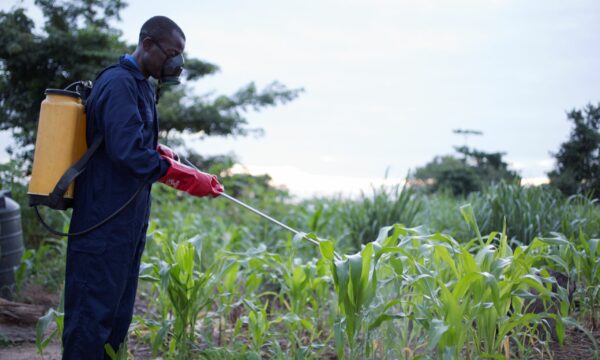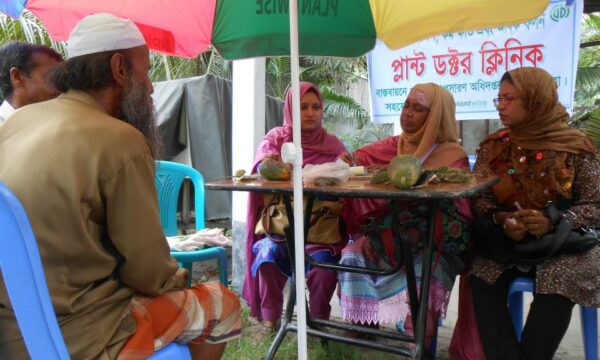Scale insects are a diverse group of small, sap-sucking insects with flat or domed shells. Their lack of mobility and protective shell make them difficult to manage. This explains why many scale species are commercial agricultural pests. Scales pierce plant tissue with their mouthparts to feed on the sap weakening the plant. Any excess fluid is secreted as honeydew, a sticky liquid which is often colonised by sooty mould (Ascomycete fungi species).

Pests of fruit trees
There are over 8000 described scale insect species. They are small, herbivorous, sap-sucking insects with extreme sexual dimorphism (there are vast differences between males and females). Females tend to be soft-bodied with no limbs and are protected by a domed shell. Males are more like flies, with legs and sometimes wings.
Some scale species are serious commercial pests, particularly of nut and fruit trees. A few examples include:
Red scale (Aonidiella aurantia) is a severe pest of citrus in the USA, Southern Africa, Australia and New Zealand, Mexico, much of South America, Israel and the eastern Mediterranean.
Native to Australia, the Cottony cushion scale (Icerya purchasi) has become widely spread throughout most of the tropical and sub-tropical countries of the world. It has also become established in southern Europe. It is a pest of citrus as well as other fruit and ornamental trees.
The San José scale insect (Diaspidiotus perniciosus) is a pest of several fruit tree species, including peach, pear, apple and plum. This species originates from eastern Asia but has spread to North and South America, New Zealand and northern Europe.
Management of scale insects: Prevention
To prevent initial infestations, purchasing certified nursery stock that is free of scales is very important.
Maintaining natural predator populations is vital for preventing scale populations from reaching a stage where they are causing significant damage. The most important natural enemies (or predators) of scale insects are ladybird beetles and green lacewings. The main parasitoids of scale insects are chalcidoid wasps. To maintain these populations, avoid using broad-spectrum insecticides and intercrop or plant attractive flowering plants to improve diversity.
In addition, ants protect scales from their natural enemies, so maintaining their local population is imperative. Removing weeds from between trees or planting ant-repellent plants like mint and cinnamon can help to reduce the ant population.
To prevent spreading scales further, clean equipment with water and check clothing before moving between areas with and without scale infestations.
Female scales only tend to move very short distances during their lives. Pruning annually can help to prevent trees from touching and therefore reduces tree-to-tree spread of scales. And when pruning, burn or bury the diseased and dried branches.
Maintaining healthy plants helps to reduce their susceptibility to scale damage. Using recommended fertilizer rates and irrigation schedules is important to keep trees as healthy as possible.

Management of scale insects: Symptoms
Due to their small size and often cryptic behaviours, they can be difficult to observe until they cause significant damage.
Scale insects tend to attack young shoots and fruits of fruit trees. Particularly citrus, apple, peach, pear and plum species. The plant generally becomes weaker with fewer leaves and buds, and honeydew can form a crust on branches and stems. Although these are the generic symptoms caused by scale insects, there is some variation depending on the species. For example:
Symptoms of red scale: yellow halos around scales’ feeding points and excreted honeydew. Heavy infestations can cause leaves to wilt and fall prematurely, dieback of twigs and branches, deformed and dropped fruits, and stunted growth in young trees.
Symptoms of cottony cushion scale: large quantities of honeydew, fruit drop, wilting leaves, defoliation, and dieback of twigs and small branches.
Symptoms of San José scale: red spots on the fruit (known as ‘chilindrina’), yellowing of the leaves and defoliation. Heavy infestations can cause branches to die and the tree to lose its vigour.
Management of scale insects: Monitoring
To monitor for scale insects during the dormant season, observe fruit trees every week. Look for the presence of scales, black sooty mould growing on excreted honeydew or small holes caused by parasitoids. Inspect approximately 5 trees per hectare, checking 5-10 twigs or branches per tree. If more than 5-10% of the sampled trees are infested, take direct control measures.
During the growing season, monitor for the movement of winged males and parasitoids using sticky traps or pheromone traps. Also, monitor weekly for the symptoms previously mentioned.
Management of scale insects: Direct control
Insecticides tend to be ineffective due to scales’ shell and waxy covering. Instead, mineral oil in contact with the scales’ shell prevents the insect from breathing and it dies. Mineral oil, like Triona 5, should be applied at the beginning of the cycle. Trees are sensitive to the oil, and if applied when plants are sprouting, flowering or fruiting, the fruit or flowers may fall. Follow the instructions on the label of the product.
There are several types of species which can be used for biocontrol of scale insects. Check with the Ministry of Agriculture in your country for local recommendations for biocontrol and consider advice from local extension officers. In tropical regions, parasitic wasps like Metaphycus luteolus and parasites like Aphytis lignanensis can be successful when released locally. Whereas in temperate conditions, A. melinus may be more suitable. Finally, in arid and hot inland areas where insecticides aren’t over-used, the Vedalia beetle (Novius cardinalis) is commonly used.
Ant populations should be controlled to prevent them from protecting scales from their natural enemies. Sticky barriers around tree trunks can be created using duct tape or fabric tree wrap coated with a sticky substance like Tanglefoot on infested trees. Double-sided sticky tape can also be used on branches. The barriers should be checked every week or two, and any debris that builds up should be removed to prevent ants from crossing the barrier.
During the summer, remove any infested branches, leaves or fruit to isolate the damage. Burn the infested plant material, or bury it at least 20cm deep.
Further reading
If you would like to find more information on this subject, please see the links below:
Keys for identifying soft scales, armoured scales and mealybugs: https://idtools.org/scales/
Visit the University of Califonia website for information about other management strategies for scale insects
CABI Plantwise Factsheet for Farmers ‘Control of scale insects in fruit trees’
For a wide range of resources relating to scale insects, including country and species-specific information, try this PlantwisePlus Knowledge Bank search
Related News & Blogs
How do pest risk registers address the spread of plant pests in Africa?
Pest risk registers can help to solve problems in agriculture, addressing the growing global threat of plant pests. Moreover, changing weather patterns, led by rising temperatures, are causing them to reproduce faster and expand into new regions. In ad…
10 July 2025




